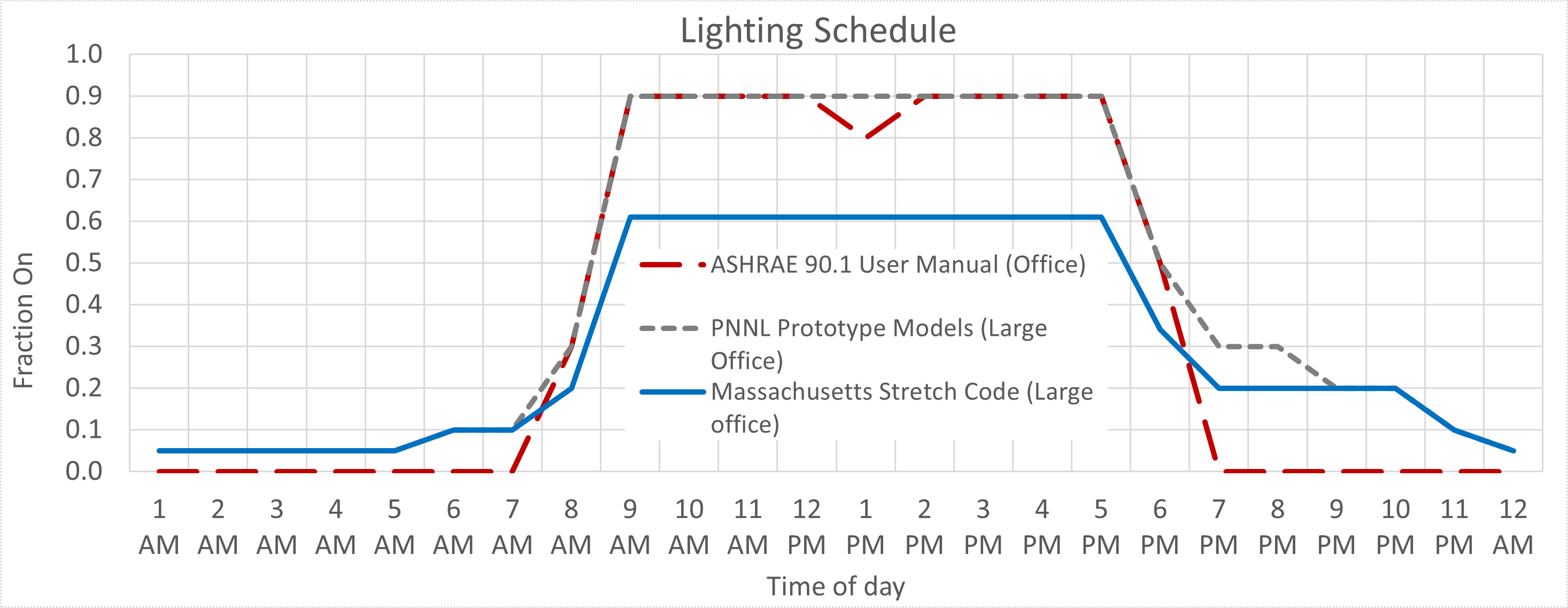I’ve noticed that different standards provide different schedule assumptions for things like occupancy, lighting, and plug loads. What schedules should I use in my model?
- Behind Schedule
Dear Behind Schedule,
Schedules can have a big impact on energy consumption and associated savings.
Energy models use many different schedules. People/occupancy, lights, plug loads, heating/cooling setpoints, and service water heating are usually the main ones, but you can include schedules for just about anything and everything. Models typically include schedules that are daily, weekly, and monthly. Seasonal schedules can be important for some buildings, like schools that aren’t used as much during the summer. Establishing appropriate seasonal schedules for these buildings can be important to inform early design decisions and to show how impactful those decisions are with the building’s specific seasonal use. Schedules can also be established for design days to inform peak loads and equipment sizing.

Figure 1. Sample weekday schedule for each major building load type from 2020 ASHRAE Standard 90.1 User’s Manual Table G-8 Office Occupancy.
Schedules are one important step in trying to have our energy models reflect what’s happening at the building as well as we can. It’s usually up to the modeler to decide what schedules to use, sometimes without a lot of guidance. ASHRAE 90.1-2022 Appendix G states the following: “The schedules shall be typical of the proposed building type as determined by the designer and approved by the rating authority.” Some “rating authorities” are starting to provide guidance on schedules coupled with performance targets (see Massachusetts below), but many rating authorities won’t provide direction on schedules.
Confirming hours of operation with the building owner or operator is important, but this doesn’t give us the granularity of hourly patterns that we need for models. And what if they just don’t know yet, for example if tenants aren’t confirmed? What if it’s a residential building? What if a “residential” building is being used for commercial purposes, as in ~50% of occupants are now working from home?
It’s always best to start with a typical schedule and then adjust it to suit any specific information you have about the building, if appropriate. For example, in residential buildings we can simply use a reference schedule. For a standard office building we might also stick with the reference schedules, but for one that is planning to operate 24/7, we might adjust the reference schedules to reflect these longer operating hours. Or, in an office that incorporates vacancy sensors for lighting, the lighting schedule might dip with the lunchtime occupancy dip shown in Figure 1. There are a few references for typical schedules that you can use, like the ASHRAE 90.1 User Manual (section Appendix G) and the PNNL Prototype Models (each scorecard has a tab for schedules).
Schedules are even more important in codes with targeted performance requirements like the new Massachusetts Stretch Code which includes modeled Thermal Energy Demand Intensity (TEDI) limits. This code gives specific schedules that need to be used in the model via the “Schedule and Loads Guidelines Supplement”. It’s important to use the required schedules when modeling for performance targets to prevent gaming (e.g. assuming lower use to get lower energy consumption) or penalizing (e.g. a building with 24/7 operation having a harder time meeting the requirements because of its use). This also means that different models may be required for the performance-based codes like the Massachusetts Stretch Code versus LEED if the required schedules don’t align well with the anticipated building use. For example, say you are modeling an office building in Boston that is required to follow the Stretch Code guidelines, but you know that one of the tenants will have a 24/7 operations center. You should advise the developer or owner that a separate model may be required to better reflect actual energy consumption, and that the code model will not reflect their intended use. Figure 2 below shows how different codes and standards can imply very different schedules–in this case, for lighting.

Figure 2. Comparison of lighting schedules implemented by different standards and codes for a large office building.
Be aware that different software programs may have different built-in schedules. Be sure to check and update them as appropriate for your project. Modeling a Passive House building? Know that Passive House models (both PHPP and WUFI-Passive) have a very different approach to schedules since they’re not hourly models, and their overall use assumptions typically don’t align with hourly models. This is one of many reasons why results from hourly and Passive House models don’t align.
And most importantly, always follow the specific modeling rules for the code, standard, or program that you’re utilizing. Be mindful that as an energy modeling professional and/or licensed engineer, it may be in your best interest to ‘test’ a few different schedules in your models to communicate their relative compliance, performance, thermal comfort, or other impacts to your clients.
That’s all we have time for; need to stay on schedule!

Brittany Coughlin, MASc, P.Eng., BEMP, CPHC, LEED AP BD+C
Principal, Energy & Sustainability Specialist
Brittany has over 15 years’ experience in energy efficient and sustainable buildings. Her primary goal is to help clients reduce greenhouse gas emissions from the built environment and adapt to climate change. Brittany provides input to design teams and stakeholders to assist projects in meeting green building performance requirements, and to cost-effectively optimize energy performance. Her work includes a wide range of projects for both new and existing buildings, including Passive House, high-performance consulting, research, and policy and program support.





